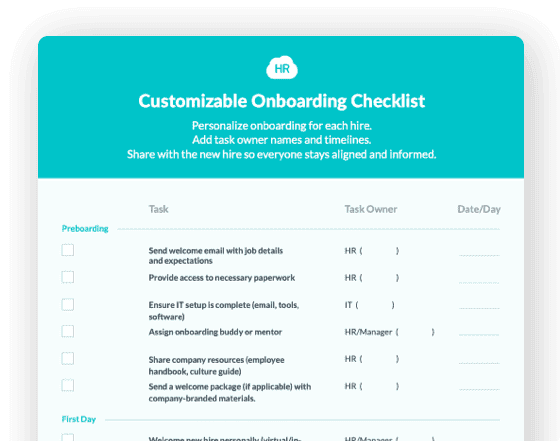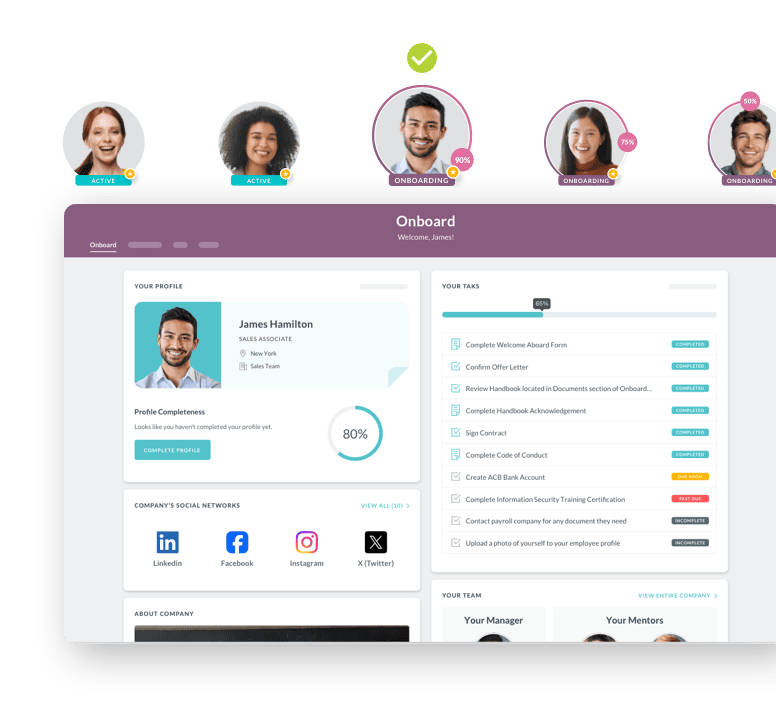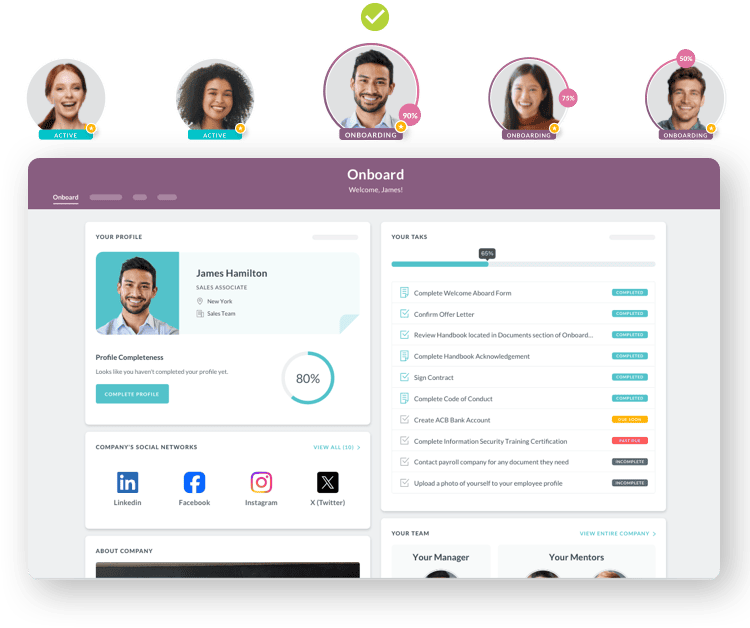Job Proof Letter
- Essential Elements Every Job Proof Letter Must Include
- When Employees Need Employment Verification Letters
- Creating an Effective Job Proof Letter Process
- Common Mistakes That Undermine Letter Effectiveness
- How Different Industries Use Employment Verification
- Step-by-Step Implementation for Your Organization
- Future Trends Shaping Employment Verification

 Cut onboarding time
by 60%—here's the
Ultimate Checklist
that helped do it.
Cut onboarding time
by 60%—here's the
Ultimate Checklist
that helped do it.

A job proof letter is a formal document that confirms your current or past employment with a company. This letter serves as official verification of your work history, job title, salary, and dates of employment. Employees need this document for many important life events, from applying for a mortgage to renting an apartment. Employers issue these letters to help their staff achieve personal and professional goals that require proof of steady income.
Understanding how to request, write, and use job proof letters properly can save time and reduce stress for everyone involved. This guide walks you through everything you need to know about employment verification letters, from their core purpose to best practices for handling requests efficiently.
Essential Elements Every Job Proof Letter Must Include
Job proof letters follow a standard business format that ensures they meet the needs of lenders, landlords, and other requesting parties. Before diving into specific sections, it's helpful to understand what makes these letters effective and credible. A well-crafted letter provides clear, accurate information without unnecessary details or legal complications.
-
The letter must include your company's official letterhead with logo, address, and contact information to establish authenticity
-
Employee details should cover full name, job title, employment dates (start and end if applicable), and employment status (full-time or part-time)
-
Salary information requires careful handling, including base pay, payment frequency, and any regular bonuses or commissions when relevant
-
Contact information for the letter writer should be prominent so recipients can verify details or ask follow-up questions
-
A professional signature and date stamp prove the letter is current and authorized by someone with proper authority
-
The purpose statement should clearly identify why the letter is being issued and what it confirms
When Employees Need Employment Verification Letters
Different life situations trigger the need for these important documents, and each scenario may require slightly different information.
|
Situation |
Who Requests It |
Key Information Needed |
Typical Timeline |
|
Mortgage Application |
Lender or Bank |
Job title, employment dates, annual salary, employment status |
2-3 business days |
|
Apartment Rental |
Landlord or Property Manager |
Current employment status, monthly income, job stability |
1-2 business days |
|
Auto Loan |
Financial Institution |
Employment verification, income level, payment frequency |
1-3 business days |
|
Visa or Immigration |
Government Agency |
Complete employment history, job duties, compensation details |
3-5 business days |
|
New Job Application |
Prospective Employer |
Job title, dates of employment, reason for leaving |
2-4 business days |
Creating an Effective Job Proof Letter Process
Smart HR teams establish clear procedures for handling verification requests efficiently. These practices protect both the company and the employee while ensuring quick turnaround times. According to SHRM's employment verification guidelines, having a formal policy in place reduces errors and legal risks.
First, designate specific people who can authorize and sign job proof letters. This might be your HR manager, department head, or another trusted leader. Clear ownership prevents confusion and ensures consistent quality. Many companies use automated onboarding and document management systems to streamline this process and maintain proper records.
Second, create a standard template that includes all required information fields. This saves time and reduces the chance of leaving out important details. Your template should align with essential onboarding documents your company already manages.
Third, establish turnaround time expectations. Most requests need fulfillment within 2-3 business days. Quick responses help your employees move forward with their plans and show you value their needs.
Fourth, implement a verification process for incoming requests. Confirm the request is legitimate before releasing any employee information. This protects against identity theft and fraud.
Fifth, keep copies of all verification letters in employee records for compliance and future reference. Digital storage makes retrieval easy when follow-up questions arise.
Sixth, train your team on privacy laws and what information can legally be shared. Some states restrict salary disclosure or other details. Understanding these nuances prevents legal complications down the road.


Common Mistakes That Undermine Letter Effectiveness
Even experienced HR professionals sometimes make errors that can delay employee plans or create legal exposure. Learning from these common pitfalls helps you avoid unnecessary problems. Managing new hire paperwork correctly from day one makes verification much easier later.
Many companies share too much information in verification letters. Stick to the facts requested and avoid subjective opinions about performance or character unless specifically asked. This protects you from potential liability if the employee doesn't get approved for whatever they're applying for.
Another frequent error is using outdated employee information. Always verify current job titles, salary figures, and employment status before finalizing the letter. Systems like E-Verify help maintain accurate employment records.
Some HR teams take too long to respond to verification requests. Delays can cost your employee a rental property or loan approval. Set up systems that allow quick turnaround without sacrificing accuracy.
Failing to verify the legitimacy of the request creates security risks. Always confirm you're sending sensitive employee data to the right party for a valid reason. This step is just as important as conducting proper background checks during hiring.
Inconsistent formatting or missing company letterhead makes letters look unprofessional and raises questions about authenticity. Always use official templates and proper business formatting.
How Different Industries Use Employment Verification
The specific details required in job proof letters often vary by industry, based on unique regulatory requirements and risk factors.
In healthcare, verification letters often need to confirm licensure, certifications, and specific credentials beyond basic employment facts. Hospitals and medical facilities require detailed documentation to ensure compliance with industry standards and patient safety protocols. These letters may include information about specialized training and continuing education.
Manufacturing and construction companies frequently need to verify safety training, equipment certifications, and union membership status. According to Indeed's employment verification guidance, these industries often require more detailed job descriptions to confirm the employee has relevant hands-on experience.
Financial services firms must be extra careful with verification letters due to strict regulatory oversight. They often need to confirm that employees passed background checks, possess required licenses, and have clean compliance records. The AIHR employment verification template guide notes that 92% of recruiters conduct thorough background verification in this sector.
Step-by-Step Implementation for Your Organization
Setting up a robust employment verification system doesn't have to be complicated. Follow these practical steps to create a process that works smoothly for everyone involved.
Start by drafting a clear company policy that explains who can request letters, who can issue them, what information will be included, and expected response times. Share this policy with all employees so they know what to expect when they need verification.
Next, create your letter template with placeholder fields for variable information like names, dates, and salaries. Include your company letterhead and signature lines. Test the template with a few sample letters to ensure it covers all common scenarios. Understanding how employment verification fits into broader hiring practices helps you design better templates.
Then, train your HR team and managers on the new process. Cover privacy laws, what information can be shared, how to verify requests, and turnaround expectations. Regular refresher training keeps everyone up to date as laws change.
After that, implement your digital storage system for keeping copies of all verification letters. Tag them properly so you can find them quickly if questions arise months or years later.
Finally, review and update your process annually. Laws change, business needs evolve, and employee feedback can reveal areas for improvement. Regular evaluation keeps your system efficient and compliant.
Future Trends Shaping Employment Verification
Technology is transforming how companies handle job proof letters, making the process faster, more secure, and more convenient for everyone. Digital transformation in HR means verification letters are becoming part of integrated employee management platforms.
Blockchain technology promises to revolutionize employment verification by creating permanent, tamper-proof records of employment history. Employees could maintain a verified credential that any employer or lender could access instantly with permission. This eliminates delays and reduces fraud.
Artificial intelligence is already helping HR teams process verification requests more efficiently. Smart systems can pull accurate employee data, populate letter templates automatically, and route requests to the right approvers. This reduces manual work and speeds up response times significantly.
Mobile-first solutions are making it easier for employees to request verification letters through apps and receive digital copies they can share immediately. This shift away from paper letters reflects broader workplace digitization trends.
Automated income verification services are gaining popularity, especially in lending. These platforms connect directly to payroll systems to provide real-time employment and income data without requiring manual letter writing. While this technology won't replace traditional letters entirely, it offers a faster alternative for routine requests.
As remote work continues to grow, employment verification processes will need to accommodate workers without traditional office settings or local HR support. Cloud-based HR systems that employees and managers can access from anywhere will become essential. The best platforms will integrate verification letter generation with other HR functions, creating seamless workflows that save time and reduce errors.
 Discover how our HR solutions streamline onboarding, boost employee engagement, and simplify HR management
Discover how our HR solutions streamline onboarding, boost employee engagement, and simplify HR management
Keep Reading
From Manual to Automated: A Complete Guide to Digitizing Employee Onboarding for Large Organizations
Sarah Chen, Director of HR at a 7,000-employee healthcare organization, starts her Monday
Enterprise HR Software in 2025: Why Traditional Enterprise Platforms Fall Short and What Actually Works
Traditional enterprise human resources software systems promise comprehensive solutions
AI in Onboarding: Complete Guide for 2026
You’ve probably been hearing this multiple times a day — AI is transforming HR. But
Ready to streamline your onboarding process?
Book a demo today and see how HR Cloud can help you create an exceptional experience for your new employees.

